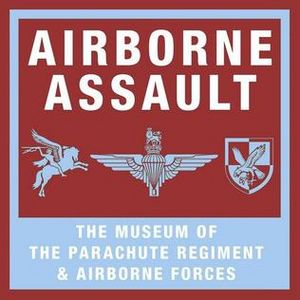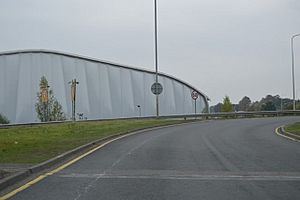Parachute Regiment and Airborne Forces Museum facts for kids
 |
|

The Airborne Assault Hangar at Duxford
|
|
| Lua error in Module:Location_map at line 420: attempt to index field 'wikibase' (a nil value). | |
| Established | 1946 |
|---|---|
| Type | Regimental museum |
| Public transit access | Stagecoach C7 from Cambridge. |
The Parachute Regiment and Airborne Forces Museum is an exciting place located at Duxford in Cambridgeshire. It tells the amazing story of the Parachute Regiment and other special airborne forces. These forces are soldiers who jump from planes or land in gliders.
Contents
The Museum's History
The idea for this museum started way back in October 1946. It was created by a group called the Parachute Regiment Association. For many years, the museum moved around different army camps.
In 1969, it found a permanent home. This was at Browning Barracks in Aldershot Garrison. A famous army leader, Field Marshal Lord Montgomery, officially opened it on March 23, 1969.
Later, in 2008, the museum moved again. It joined forces with the Imperial War Museum Duxford. This new home was given the name "Airborne Assault." Charles, Prince of Wales (who is now King Charles III), opened the new museum on December 8, 2008.
What You Can See: Museum Exhibits
The museum has cool new displays that use multimedia. They show what it's like to be an airborne soldier today. You can also learn about their history, starting from 1940. That's when British Airborne Forces were first created. Prime Minister Winston Churchill really wanted them!
World War II Operations
The exhibits include original models used for planning airborne missions in World War II. You can see models for famous events like the Bruneval Raid. There are also models for D-Day and the Rhine Crossing.
A special part of the museum explains the battle of Arnhem. This was a big part of Operation Market Garden. You can understand how the battle happened step by step.
Post-War Campaigns and Equipment
The museum also covers battles after World War II. These include conflicts in Borneo and Suez. You can learn about the Falklands War, Northern Ireland, and Afghanistan.
You'll see displays of light weapons used by soldiers. There's also heavy equipment like jeeps and field guns. These are hung up to look like they are dropping from the sky!
Famous Glider and Dog
One special item is the front part of an Horsa glider. These gliders carried troops into battle in Normandy and at the Rhine. You can also see a stuffed dog named Bing the Paradog. He was a real dog who jumped with soldiers in 1945!
Medal Gallery: Honoring Heroes
The Medal Gallery shows many medals given to British airborne troops. These include very brave awards called the VC.
Victoria Cross Recipients
You can see the VCs given to Lieutenant John Hollington Grayburn. He was from the 2nd Battalion the Parachute Regiment. Captain Lionel Ernest Queripel of the 10th Battalion also received one. Another VC on display was given in 2007 to Corporal Bryan Budd of the 3rd Battalion. These medals are given for extreme bravery.
ParaData: An Online Resource
The museum also has a special online resource called ParaData. This is a huge database about everyone who has served in the Parachute Regiment and Airborne Forces. It's like a big digital history book!
What ParaData Contains
ParaData has details about soldiers and the battles they fought in. It includes photos, documents, letters, and even video and audio interviews. People can also add more information to it.
This database helps keep the history of these forces alive. It's also a great way for younger people to learn. It uses modern technology to make history interesting and easy to explore.
Gallery
-
Bing the ParaDog with his Dickin Medal







